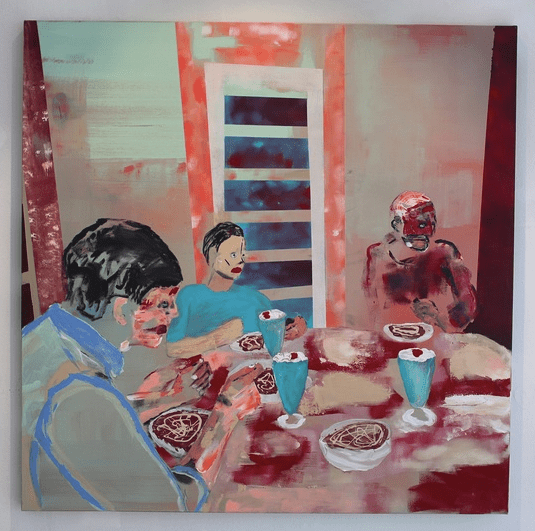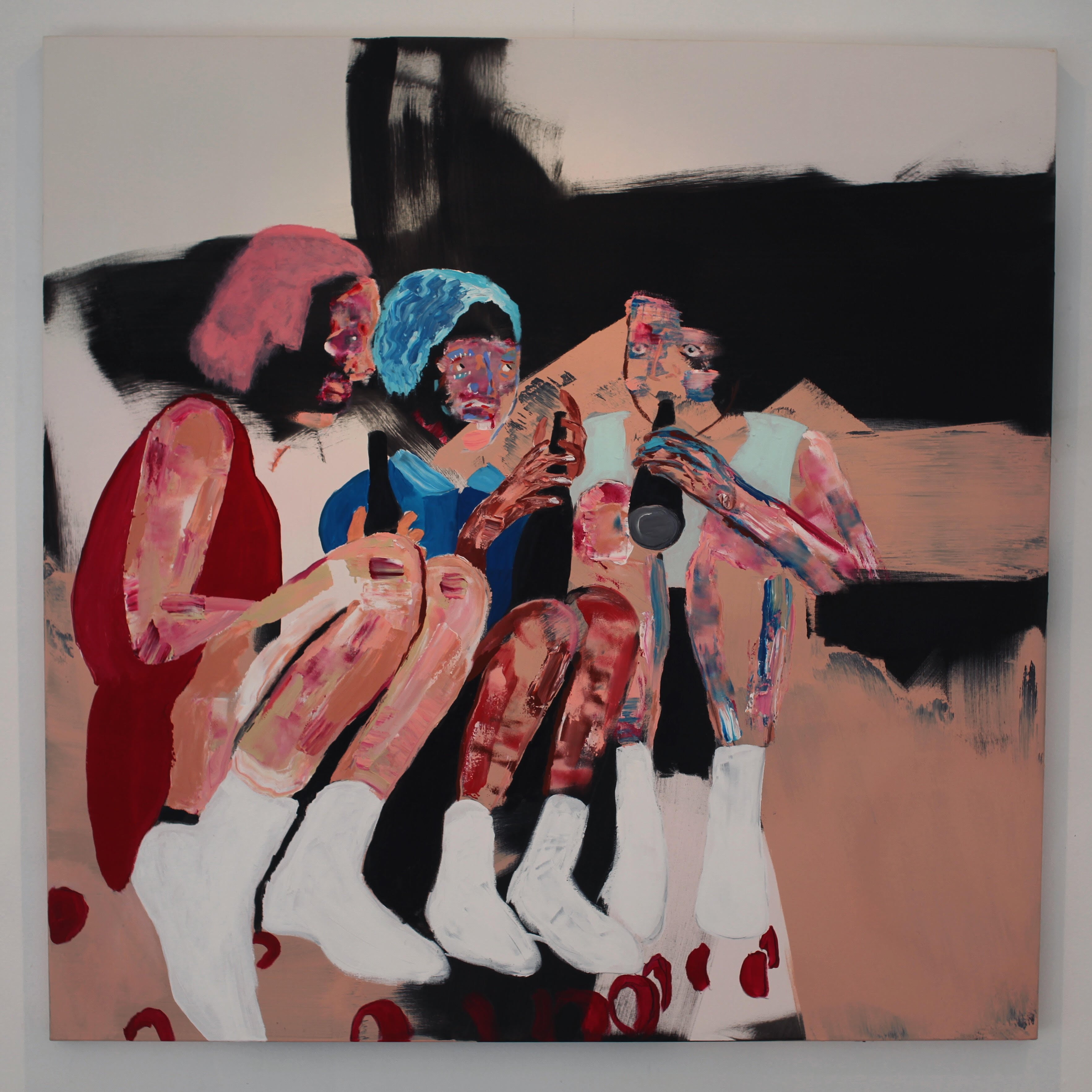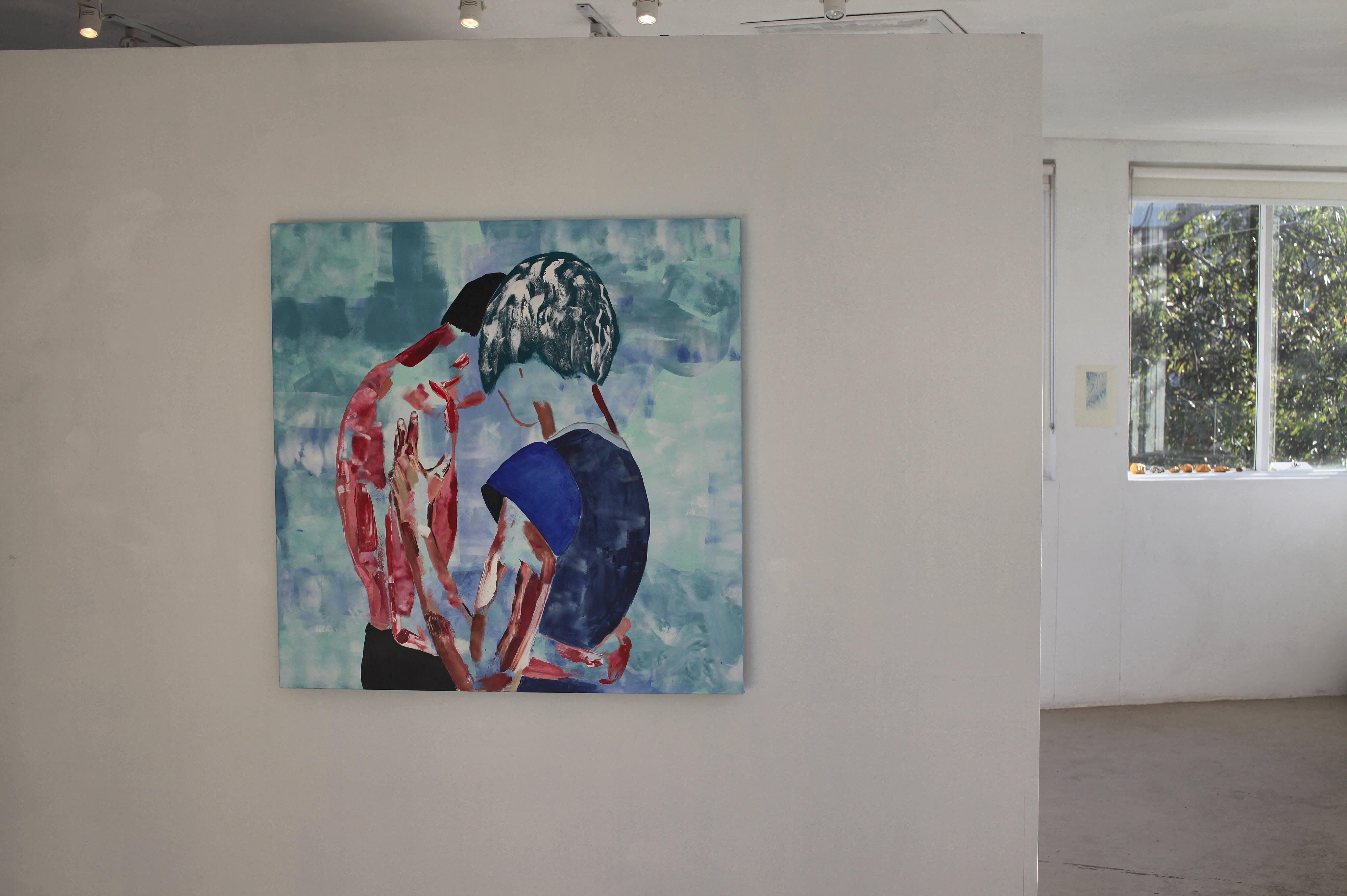


a body
of assumptions
a mind
coerced into trusting
your prescribed narrative
has me flattening
concealing
trying to be loud
though pillowy lips and building blocks
reverse my progress
it is these marks
from which
resurrection trembles
Over the course of their emerging career, Felix Atkinson’s artistic practice has worked towards resisting dominant frameworks of identity and relationships. Exhibiting for the first time at Rubicon ARI, soft trees break the fall represents a development from their earlier abstract portrait works. The paintings in this suite draw on the artists’ unique approach to space; they are zoomed out to encompass figures in their surroundings, a representation of isness.
The mechanics by which oppression and silence interact are often repackaged and repurposed through artist practice to acknowledge a ‘diversity’. Inherent within this is the risk of appropriation or tokenisation, sometimes phantom. Atkinson’s work offers another approach — through an abstract rendering, identifiers like clothes, hair colour, skin tone and colour work to embody any (and every) one’s personal histories rather than prescribe a specific one. The materiality of the painting provides visual cues that are simultaneously recognisable and vague; there is proximity and yet distance.
The works, eight paintings in total, depict subjects within a space, the nature of which is often (and to a degree) undefined and ambiguous. Though the depiction of space disorientates, the life-size subjects engulf it; Atkinson’s dramatic use of pictorial space isolates figures and grounds us through that familiarity. Via abstraction, we are able to interpret the figures autonomously, without imposed narratives — we are not guided by dominant (white- and hetero-normative) identifiers and expectations. The ambiguity prompts a different way to engage: with space, with rooms, with subjects, with an untethered reality. Personal experiences permeate the abstract scenes producing, with agency, our ‘story’, one that is obscured from other viewers. Atkinson allows us to identify and comprehend the dynamic and quiescent nature of everyday human interaction with mechanics that re-orient the institutionalised structures we may have otherwise used to construe them.
The complex interplay between self and mask which come through in the works that make up Atkinson’s latest show adapts and transforms our understanding of identity, both personal and contextualised within the broader landscape of ‘Australia’. Atkinson’s entrenchment in subjective investigations opens up their work, reorienting the process of interpretation in viewers.
It is precisely this blurring of identity that grounds this exhibition firmly in the contemporary politics and ethics of identity. If it is you who is viewing, then what do you see and whose narrative are you prescribing to the depictions in the paintings? I think to Alexis Wright here in her piece ‘What happens when you tell somebody else’s story’ (2016): do our perceptions match our experiences? Atkinson’s work posits a pervasion of dominant forms of interpretation, relying instead on the viewer’s disposition and it is herein that we are left without a replicable optic: mine differs from yours. The undefined narratives in the work are provocative; they offer a tender intimation to interrogate our assumptions. These paintings don't tell someone else's story. We can only posit our own personal (hi)stories into the figures represented; at once reassuring yet destabilising.
Atkinson’s compositions feel dreamlike, nostalgic. Subjects negotiate space and other counterparts in ways that unsettle the kind of domesticity that could otherwise be imagined around socialised settings of a dining table or sofa or bed, those which are so firmly rooted in reality and loaded with expectation. With spatial and relational disorientation rendered through abstraction, the work spagetthhi (2019) does not provide the comfort I might expect to feel when a meal and a drink are involved. But ... blue heaven milkshakes with maraschino cherries? It is a disconcerting kind of nostalgia. And then, there is a particular accentuation of tenderness in the way a hand rests or in the creases which are made in skin when a posture is held. There is an instinctiveness in Atkinson’s unlaboured brushstroke work and, bolstered by contrasting textures and a romantic palette, we see (and reveal) ourselves in these portrayals — undercurrents pertaining to familiar and sensual things in our lives.
In the exhibition catalogue for soft trees break the fall we read: ‘the paintings carry within them the bittersweet realisation of the ephemeral nature of all things.’ The artist uses space in such a way that suggests a temporariness of moments and interactions — remove one line and the subject disintegrates into the non-defined space it inhabits, into a haze of colour and texture. With a figurative tradition reminiscent of Francis Bacon, Atkinson’s temporary moments and the feelings embedded in them are a guise for the challenges that our bodies pose: for transience, for space, for visibility, for vulnerability, for identity. In the work xenia, OH (2019), for instance, we see an almost juvenileness in posture but the faces on the subjects, with their abstracted aesthetic, arrest us, harbouring an emotion/spirit at once complex and stifling. There is an exhaustion in the messy dynamics of dependence and detachment, and it begs the question: where are we?
Jo Pugh is a Fijian-Indian writer, facilitator and artist based in Naarm. Their work explores and centres queerness, brownness and marginalisation.
